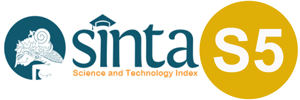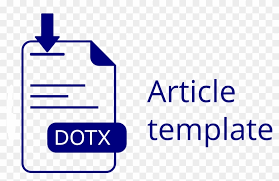Pendekatan secara in silico senyawa inhibitor ACE2 dari Senyawaan Ekstrak Asparagus Sebagai Kandidat Obat SARS-CoV-2
DOI: 10.55075/wa.v46i1.83Sari
Virus SARS-CoV-2 telah menjadi pandemik sejak menyebar melalui kontak erat penyintas dari kota Wuhan, virus ini telah bermutasi menjadi varian B.117 yang telah ditemukan kasusnya di Inggris Raya. Pemblokiran antara spike glikoprotein virus dengan ACE2 dapat terjadi saat pasien memproduksi antibodi, seperti saat pemberian vaksinasi SARS-CoV-2 kepada pasien sehingga antibodi dapat berikatan dengan spike protein dan mencegah pembentukan ikatan dengan ACE2, ataupun dengan penggunaan suatu senyawa yang dapat berikatan dengan spike glikoprotein virus sehingga proses pembauran virus dengan sel inang dapat dicegah. Kehadiran spike glikoprotein yang berikatan dengan ACE2 menjadi jalur penting bagi siklus hidup virus dan diyakini sebagai target utama untuk diblokir. Asparagus mengandung senyawa-senyawa yang ada memiliki aktivitas antivirus yang sampai saat ini belum ada penelitiannya baik secara in vitro maupun maupun in vivo, sehingga perlu dilakukan penelitian secara in-siliko untuk menapisnya. Dari hasil penelitian didapatkan bahwa senyawa Dioscin memiliki interaksi terkuat dengan situs aktif ACE2 diantara senyawa 67 senyawa kandidat lainnya yaitu sebesar -7.5 kkal/mol.
Kata kunci: ACE2; Asparagus; Covid19; Sars-Cov-2; Shatavarin VII
Teks Lengkap:
PDFReferensi
[PDPI] Persatuan Dokter Paru Indonesia. 2020. Pneumonia COVID-19. Jakarta (ID): PDPI.
Bahadur, A., Ajmal, M., Lee, J., & Abul, M. 2020. Since January 2020 Elsevier has created a COVID-19 resource centre with free information in English and Mandarin on the novel coronavirus COVID- 19 . The COVID-19 resource centre is hosted on Elsevier Connect , the company ’ s public news and information , (January).
Biovia, D.S. (2015). Discovery Studio Modeling Environment. San Diego (US): Dassault Systems.
Chikhale R V., Sinha SK, Patil RB, Prasad SK, Shakya A, Gurav N, Prasad R, Dhaswadikar SR, Wanjari M, Gurav SS. 2020. In-silico investigation of phytochemicals from Asparagus racemosus as plausible antiviral agent in COVID-19. J Biomol Struct Dyn. 0(0):1–15. doi:10.1080/07391102.2020.1784289.
Duniaji, A. S., Suprapta, D. N., Puspawati, N. N., & Yoga, I. B. (2016). Studi komponen bioaktif asparagus (Asparagus officinalis) dan potensinya sebagai antioksidan. Jural Ilmiah Teknologi Pertanian AGROTECHNO, 1(1), 56–61.
Du X, Li Y, Xia YL, Ai SM. 2016. Insights into protein-ligand interactions: mechanisms, models, and methods. International Journal of Molecular Sciences. 17(2): 1-34. doi: 10.3390/ijms17020144.
Gangadevi, S., Badavath, V.N., Thakur, A., Yin, N., De Jonghe, S., Acevedo, O., et al. (2021). Kobophenol A Inhibits Binding of Host ACE2 Receptor with Spike RBD Domain of SARS-CoV-2, a Lead Compound for Blocking COVID-19. J Phys Chem Lett ,12:1793–802. https://doi.org/10.1021/acs.jpclett.0c03119.
Goodsell, D. S. and Olson, A. J. (1990), Automated Docking of Substrates to Proteins by Simulated Annealing Proteins:Structure, Function and Genetics., 8: 195-202.
Gurung, A. B. et al. 2020. Unravelling lead antiviral phytochemicals for the inhibition of SARS-CoV-2 Mpro enzyme through in silico approach. Life Sciences. Elsevier, 255(May), p. 117831. doi: 10.1016/j.lfs.2020.117831.
Harisna AH, Nurdiansyah R, Syaifie PH, Nugroho
DW, Saputro KE, Firdayani, et al. In silico investigation of potential inhibitors to main protease and spike protein of SARS-CoV-2 in propolis. Biochem Biophys Reports 2021;26:100969.
Hoffmann M, Kleine-Weber H, Schroeder S, Krüger N, Herrler T, Erichsen S,39 Schiergens TS, Herrler G, Wu NH, Nitsche A, et al. 2020. SARS-CoV-2 CellEntry Depends on ACE2 and TMPRSS2 and Is Blocked by a Clinically ProvenProtease Inhibitor. Cell. 181(2):271-280.e8. doi:10.1016/j.cell.2020.02.052.
Idrees S, Ashfaq UA. 2014. Discovery and design of cyclic peptides as dengue virus inhibitors through structure-based molecular docking. Asian Pacific Journal of Tropical Medicine. 7(7):513-516. doi: 10.1016/S1995-7645(14)60085-7.
Jiménez-Sánchez, C., Lozano-Sánchez, J., Rodríguez-Pérez, C., Segura-Carretero, A., Fernández-Gutiérrez, A. (2016). Comprehensive, untargeted, and qualitative RP-HPLC-ESI-QTOF/MS2 metabolite profiling of green asparagus (Asparagus officinalis). J Food Compos Anal, 46:78–87. https://doi.org/10.1016/j.jfca.2015.11.004.
Lan J, Ge J, Yu J, Shan S, Zhou H, Fan S, Zhang Q, Shi X, Wang Q, Zhang L et al. 2020. Structure of the SARS-CoV-2 spike receptor-binding domain bound to the ACE 2 receptor. Nature. 1-16. doi: 10.1038/s41586-020-2180-5.
Lisiewska Z, Kmiecik W, Slupski J. 2004. Content of chlorophyll and carotenoids in frozen dill : effect of usable part and pre-treatment on the content of chlorophyll and carotenoids in frozen dill (Anethumgraveolens L), depending on the time and temperature of storage. Food Chemistry 84: 511-518.
Morris GM, Huey R, Lindstrom W, Sanner MF, Belew RK, Goodsell DS, Olson AJ. 2009. AutoDock4 and AutoDockTools4: automated docking with selective receptor flexibility. J Comput Chem. 30(16):2785-2791. doi:10.1002/jcc.21256.
Mulyati B. 2016. Studi Komputasi Interaksi Isoflavon Dengan Reseptor Estrogen Β Menggunakan Metode Oniom. EduChemia. 1(2):137–148.
Morris G,M., Huey R., Lindstrom W., Sanner M.F., Belew R,K., Goodsell, D.S., Olson, A.J. (2009). AutoDock4 and AutoDockTools4: automated docking with selective receptor flexibility. J Comput Chem, 30(16):2785-2791.
Noviardi H, Fachrurrazie F. 2015. Potensi Senyawa Bullatalisin Sebagai Inhibitor Protein Leukotrien a4 Hidrolase Pada Kanker Kolon Secara in Silico. FITOFARMAKA J Ilm Farm. 5(2):65–73. doi:10.33751/jf.v5i2.410.
Sidiq, T., Khajuria, A., Suden, P., Singh, S., Satti, N. K., Suri, K. A., … Johri, R. K. (2011). A novel sarsasapogenin glycoside from Asparagus racemosus elicits protective immune responses against HBsAg. Immunology Letters, 135(1–2), 129–135. https://doi.org/10.1016/j.imlet.2010.10.013.
Tai W, He L, Zhang X, Pu J, Voronin D, Jiang S, Zhou Y, Du L. 2020. Characterization of the receptor-binding domain (RBD) of 2019 novel coronavirus: implication for development of RBD protein as a viral attachment inhibitor and vaccine. Cellular and Molecular Immunology. 17: 613-620. doi: 10.1038/s41423-020-0400-4.
Tripathi A, Bankaitis VA. 2017. Molecular docking: from lock and key to combination lock. Journal of Molecular Medicine and Clinical Applications.2(1): 1-19. doi: 10.16066/2575-0305.106.
Trott, O., & Olson, A. J. (2010). AutoDock Vina: improving the speed and accuracy of docking with a new scoring function, efficient optimization, and multithreading. Journal of computational chemistry, 31(2), 455-461.
Walls AC, Park YJ, Tortorici MA, Wall A, McGuire AT, Veesler D. 2020. Structure, function, and antigenicity of the SARS-CoV-2 spike glycoprotein. Cell. 180: 281-292. doi: 10.1016/j.cell.2020.02.058.
Wulanawati A, Noviardi H, Ibrohim MSM. 2018. Finding a potential bruceine d inhibitor for apoptotic resistance protein pancreatic cancer based on molecular docking. Indones J Chem. 18(3):566–572. doi:10.22146/ijc.25220.
Yan, R., Zhang, Y., Li, Y., Ye, F., Guo, Y., Xia, L., et al. (2021). Structural basis for the different states of the spike protein of SARS-CoV-2 in complex with ACE2. Cell Res, 31:717–719. https://doi.org/10.1038/s41422-021-00490-0.
Yang, T. J., Yu, P. Y., Chang, Y. C., Liang, K. H., Tso, H. C., Ho, M. R., … Hsu, S. T. D. (2021). Effect of SARS-CoV-2 B.1.1.7 mutations on spike protein structure and function. Nature Structural and Molecular Biology, 28(9), 731–739. https://doi.org/10.1038/s41594-021-00652-z.
Zhou, Y., Vedantham, P., Lu, K., Agudelo, J., Carrion, R., Nunneley, J. W., … Simmons, G. (2015). Protease inhibitors targeting coronavirus and filovirus entry. Antiviral Research, 116(February), 76–84. https://doi.org/10.1016/j.antiviral.2015.01.011.
Refbacks
- Saat ini tidak ada refbacks.

















